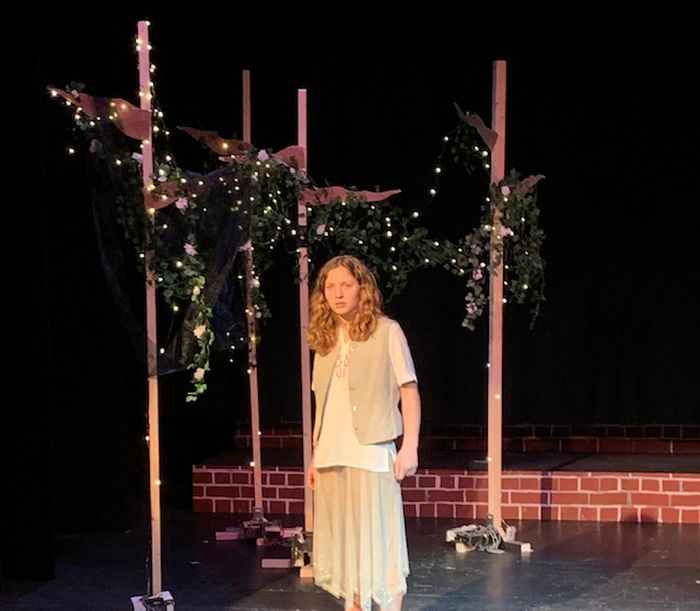An Enemy of the People is a thematic playground
Theatre Editor Bethan Holloway-Strong is overwhelmed by the extremes of this week’s ADC mainshow

Magdalena Gabrysiak’s directorial vision promises anything but a boring take on this Ibsen classic. My first impression is Matthew Wadey’s colourful set design, and although a bit busy and not always cohesive, it certainly makes a bold statement. This production of An Enemy of the People grounds itself in its vision of “child’s play”, complete with soft toys flung across the stage, sippy cups, and child actors. Gabrysiak has fully committed to her theme, but it doesn’t always serve her production well. Some of the play’s more serious moments lose their credibility, and some moments of excellent acting are slightly drowned out. When the prudent townsman Aslaksen (Zachary Green) cautions Dr Stockmann (Joe Harrington) to behave with “moderation”, it seems he could also have been speaking to the production design itself.
“I couldn’t help but feel that the inclusion of child actors was slightly gratuitous”
At the core of this production is the interpersonal relationships between the citizens, and the actors certainly do an admirable job. Some performances are significantly more successful than others: Harrington and Iona Rogan shine as siblings Thomas and Pavla Stockmann. Harrington’s performance is dynamic and impassioned, and although it borders on one-note, he manages to pull his characterisation into three dimensions with some quieter, more reflective moments. Rogan’s Pavla is cold and disciplined, but not without eye-catching flickers of sympathy deftly woven into her performance. It is in their sibling relationship, however, that these actors really shine. Their antagonism is thrilling to watch, and they both deal excellently with Ibsen’s verbose text. Complementing this fierce central rivalry, Gabrysiak brings Dr Stockmann’s long-suffering wife Katherine to life, allowing the character a bit of backbone, and Alessandra Rey’s portrayal of their daughter Petra gives a much-needed breath of calm air.

The inclusion of child actors was an interesting choice, and something that I was very intrigued about. While the actors were very talented, I couldn’t help but feel that their inclusion was slightly gratuitous. They sat on stage for long periods of time, playing quietly in the corner of the living room, and it sometimes made scenes feel like the boring conversations adults have around you when you’re young. Apart from one very impactful final scene, I felt that, despite their talents, this production wasn’t the place for children.
“Busy lighting changes occasionally interrupted the flow of scenes”
Unfortunately, the production’s design theme of “child’s play” overwhelmed some of the show’s more serious messages. The colourful set was matched with Rebecca Brooke’s equally colourful lighting design, and the combination was sometimes too extreme. Busy lighting changes occasionally interrupted the flow of scenes, but there were also some incredibly visually impactful moments: Dr Stockmann lit from behind in blood red was breath-taking. The upper level of the set was employed very effectively in moments like this, but the archway from the back passage on the lower level was so low it caused most actors to stoop, making entrances much less effective. The set decoration resembled a swimming pool, which was very fitting for the plot but made the modernisation of the play slightly confusing. The vibrant blue stripe on the back panels of the set was reminiscent of 1970s interior design, and the mismatched sofas and chairs gave the scenes a vintage feel. Harry Dixon-Spain’s costumes, while beautiful, didn’t always help with this – Mrs Stockmann’s patterned blouse only added to the 70s vibes, and Dr Stockmann’s thick grandfather-style cardigan made it feel slightly ironic as he railed against the “older generation”. Everything was executed skilfully, but each element didn’t really cohere.
The props were perhaps the biggest let-down. I could see Gabrysiak’s vision, but the scenes of Dr Stockmann and his comrades drinking sombrely from sippy cups went from the sublime to the ridiculous. They had the audience in stitches despite the righteous remonstrations of one audience member exclaiming, “For heaven’s sake!”. I understand that Gabrysiak wanted to question the traditional seriousness of productions of Ibsen, or maybe have the audience criticise Dr Stockmann’s fanatical adherence to his idea of the “truth”, but I think the actors’ strong performances could have stood alone in this regard. It was an ambitious theme, and it really is a shame that it didn’t achieve its potential.
This was certainly a thought-provoking production, and all the actors dealt with the intricacies of Ibsen’s text with skill and grace. The tasteful audience participation worked to help include us in the production, and we all watched in collective horror as Harrington’s principled doctor fell from proclamations of truth into moral ambiguity. This production did make me think a lot about truth. There are no outright lies in this play: characters conspire against each other and twist words, but what some characters consider “lies” are actually just different interpretations of the events that take place. In a similar vein, I’m sure some people found this production fresh and engaging rather than overwhelmed by its theme. In fact, I hope they did.
 News / SU reluctantly registers controversial women’s soc18 December 2025
News / SU reluctantly registers controversial women’s soc18 December 2025 Features / Should I stay or should I go? Cambridge students and alumni reflect on how their memories stay with them15 December 2025
Features / Should I stay or should I go? Cambridge students and alumni reflect on how their memories stay with them15 December 2025 News / Dons warn PM about Vet School closure16 December 2025
News / Dons warn PM about Vet School closure16 December 2025 News / Cambridge study finds students learn better with notes than AI13 December 2025
News / Cambridge study finds students learn better with notes than AI13 December 2025 Comment / The magic of an eight-week term15 December 2025
Comment / The magic of an eight-week term15 December 2025









